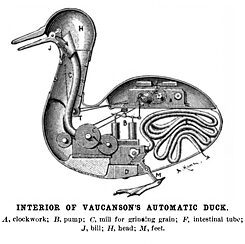Robots and Popular Culture
A Whisper from My Ghost°

Through novels, films, and television series robots have been capturing public imagination through a variety of media.
By Priscilla Jolly
They have been portrayed as ‘cyborgs’ in Ghost in the Shell (1995), as ‘replicants’ in Blade Runner/Blade Runner 2049 (1982, 2017) and as ‘technosapiens’ in the more recent After Yang (2021). While the popular examples showcased here draw from the twentieth century, the current fascination with robots and
 An American artist's (mistaken) drawing of how the Digesting Duck may have worked
| By A. Konby (?) - Internet Archive, Public Domain
machines has a longer history. For instance, the eighteenth century saw the creation of ‘miraculous’ automata by the French inventor, Jacques Vaucanson. In 1737, he created an automated machine called ‘The Flute Player’ which was able to perform 12 songs. Vaucanson also created the ‘Digesting Duck’ two years later, a replica of a duck that could quack, drink water, and eat. Our imagination of automata and robots has come a long way from an approximation of a duck that had a hidden compartment of pre-digested food that fooled the onlookers into thinking that the duck was capable of real biological processes.
An American artist's (mistaken) drawing of how the Digesting Duck may have worked
| By A. Konby (?) - Internet Archive, Public Domain
machines has a longer history. For instance, the eighteenth century saw the creation of ‘miraculous’ automata by the French inventor, Jacques Vaucanson. In 1737, he created an automated machine called ‘The Flute Player’ which was able to perform 12 songs. Vaucanson also created the ‘Digesting Duck’ two years later, a replica of a duck that could quack, drink water, and eat. Our imagination of automata and robots has come a long way from an approximation of a duck that had a hidden compartment of pre-digested food that fooled the onlookers into thinking that the duck was capable of real biological processes.
An Accident of History
Katherine Hayles opens her book How We Became Posthuman with a scenario that involves the Turing Test, which also the subject of the film Ex-Machina (2014). The Turing test, also called the imitation game, verifies whether a machine is capable of humanlike thought and consciousness. Hayles writes that the Turing test captures a moment where intelligence becomes an act of playing with symbols and manipulating information, rather than being something encased in human flesh.¹ This is a characteristic of
The "standard interpretation" of the Turing test, in which C, the respondent, has the task of finding out which participant - A or B - is a computer and which is a human. The respondent is restricted to written communication.
| © Hugo Férée, CC BY-SA 3.0 via Wikimedia Commons
the posthuman view, which sees the biological human body “as an accident of history rather than an inevitability of life.”¹ That being said, representations of robotic futures are frequently concerned with different characteristics of humanness, whether it be being human in terms of appearance, or exhibiting human behaviour.
Contesting Dualisms
It is impossible to write about cyborgs without referencing Donna Haraway’s seminal work, A Cyborg Manifesto. She describes a cyborg as “a cybernetic organism, a hybrid of machine and organism, a creature of social reality as well as creature of fiction.”² For Haraway, a cyborg embodies a confusion of boundaries, contesting dualisms that have been a hallmark of western culture. These include the self/other, mind/body, male/female among others. In popular representations of robots, the self/other duality is often being played out. Being human becomes a quality that is defined at the expense of what is not human.³Ex-Machina and Blade Runner offer us different illustrations of the quality of being human. In Ex-Machina, we are presented with two robots: Ava and Kyoko. Ava has already passed the Turing Test. She participates in a series of conversations with an observer who will determine whether she has consciousness. If consciousness is a uniquely human trait that will set Ava apart, then Kyoko showcases its antithesis. Kyoko is mute; her creator claims that she doesn’t understand English, and she exists solely to perform housekeeping duties and to satisfy her creator’s sexual needs. Ava, racially coded as white, gets to exercise her thinking faculties, while Kyoko, who is coded as Asian, is rendered mute in the film. The hierarchies within the human make their presence felt in robotic representation as well.
“Having a Heart is Heart Breaking.”
Blade Runner presents the dualism of the self and the other in a different way. K, the replicant who works as a detective, is referred to by slurs: a ‘skin job’ and a ‘skinner’ implying that his humanness is only skin-deep. Contrast replicant K with his holographic girlfriend Joi. While K deals with the stratified society, Joi, the non-embodied holographic form, takes care of him. Both Ex-Machina and Blade Runner thus present robotic representations that perform care-work: Kyoko who does housework and meets the sexual needs of her creator, and Joi who provides K with conversation and attempts to reassure him.The role of care work is also addressed in the Japanese film Air Doll (2009), which features an inflatable sex doll which comes to life. While not about a robot, the film, through a doll named Nozomi, captures yet another defining facet of robotic representation in popular culture: a ‘heart’ or consciousness that signifies humanness. After developing a heart, Nozomi spends her time learning to pass as human. For instance, she is overjoyed when she discovers that she can hide the seams of her inflated body with concealer. In an act of care, Nozomi offers concealer to a woman on the street, dressed in sheer tights with black seams on them, when she mistakenly thinks that the seams mean that the woman is like her, a doll come to life. Nozomi is used by the men in the film to satisfy their sexual needs, and she concludes that “having a heart is heart breaking.”
The practice of care and the question of memory are also addressed in After Yang. The film is set in a future where is new class of being named ‘technosapiens.’ Yang, an AI who has fun facts about Chinese culture, is bought by a family to help their daughter, Mika, a Chinese adoptee, to connect with her heritage. Mika calls Yang gēge (哥哥), mandarin for elder brother while Yang calls Mika mèimei (妹妹), meaning younger sister, hinting at the bonds of kinship between them.
The film shows how Yang’s most memorable moments in his life involved the people that he felt connected to, unprecedented for a technosapiens. Memory and connecting with people are shown as a human trait. Similar to K from Blade Runner, we see Yang wishing he had ‘real’ memories. Memory, not simulations or implants, becomes a defining characteristic of being human.
Divorced from the Realities of the World
Whether it be the cyborgs from Ghost in the Shell or the ‘techno’ carers from After Yang, the question of robots and pop culture is tied to the question of work. Robotic bodies often perform work that is undesirable for humans, including acts of care and desire. As the CEO from Blade Runner puts it: “Every civilization was built off the back of a disposable work force.” This observation then prompts the questions about the drives that power the imagination of techno-futurist utopias and dystopias. What kinds of work is pushed on to robot bodies? What implications does such a move hold for contemporary society?Take for instance, the AI tool that has dominated the news cycle, Chat GPT. A Time Magazine investigation found that in an effort to clean up the racist and sexist material produced by Chat GPT, the company Open AI hired workers from Kenya while paying them less than $2 an hour. These workers reviewed and scrubbed disturbing material so that Chat GPT became more suitable and safe for public consumption. While Chat GPT appears as a disembodied source of information to its users, this investigation reveals that this illusion is sustained on the backs of workers in Kenya. This development calls into question the image of the machine as divorced from the realities of the world it occupies. Scholars have shown how existing biases are reproduced by technology. With these traditions in mind, think back to the notion of the ‘ghost’ from Ghost in the Shell. What spectral presences power techno dreams? Whose work powers these dreams? As Haraway reminds us, “there was always the spectre of the ghost in the machine.” ²
Notes
° The title for this article comes from the cyberpunk film Ghost in the Shell (1995). The title of the film itself is a reference to consciousness that inhabits a bodily shell.
¹ Hayles, Katherine, "How We Became Posthuman: Virtual Bodies" in Cybernetics, Literature, and Informatics (Chicago: The University of Chicago Press, 1999)
² Haraway, Donna, "A Cyborg Manifesto: Science, Technology, and Socialist-Feminism in the Late Twentieth Century", in Simians, Cyborgs and Women: The Reinvention of Nature (New York: Routledge, 1991), 149 & 2.
³ The history of ‘human’ as a category is also relevant here. Recent work by black philosophers has shown how ‘the human’ was constructed as a category by excluding racialized peoples across the world. For instance, Sylvia Wynter writes about the invention of the category of ‘man,’ which was instrumental in developing the concept of humanness. The category of ‘man’ and ‘humanness’ is built by excluding racialized peoples. See Wynter, Sylvia, “Unsettling the Coloniality of Being/Power/Truth/Freedom: Towards the Human, After Man, Its Overrepresentation--An Argument,” The New Centennial Review, 3, no. 3, (2003): 257-337. For a summary of Wynter’s argument about the human see McKittrick, Katherine, “Demonic Grounds: Sylvia Wynter,” in Demonic Grounds: Black Women and the Cartographies of Struggle (Minneapolis: University of Minnesota Press, 2006), 124-127. Also see Weheliye, Alexander, Habeas Viscus: Racializing Assemblages, Biopolitics, and Black Feminist Theories of the Human (Durham: Duke University Press, 2014).